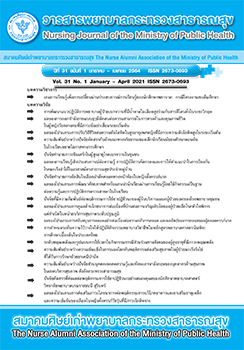Game-based Education for a Transformation of Nursing Students’ Learning Experiences: The STEM Education Project
Main Article Content
Abstract
Twenty-first century education emphasizes the development of the competence of students to be able to apply their knowledge to practice in their work and life in the context of changing society. Game Based Education (GBE) is a teaching method that brings fun so as to motivate students to continuously learn. GBE provides opportunities for teachers to promptly give reasons and suggestions after ending activities. The steps of GBE consist of designing games, planning teaching activities, implementing teaching methods, and conducting evaluation. Evaluation methods include authentic assessment and reflection since the students learn in real situations. The evaluation should assess performance, process, and products of learning. Reflection is an individual evaluation by allowing students contemplatively think about their learning situations. Reflection is an important step in transforming students’ learning. The STEM education project is an example of applying GBE as a teaching method in this article. The teacher needs to analyze the course content and desired learning outcomes in order to design games to motivate students’ learning from the project and to achieve desired learning outcomes. The GBE would be able to transform students learning experiences if appropriately designed.
Article Details
บทความและรายงานวิจัยในวารสารพยาบาลกระทรวงสาธารณสุข เป็นความคิดเห็นของ ผู้เขียน มิใช่ของคณะผู้จัดทำ และมิใช่ความรับผิดชอบของสมาคมศิษย์เก่าพยาบาลกระทรวงสาธารณสุข ซึ่งสามารถนำไปอ้างอิงได้
References
2. Hayes A. Game theory [internet].2020 [cited 2020 December 12]. Available from:https://www.investopedia.com/
terms/g/gametheory.asp.
3. Hromek R, Roffey S. Promoting social and emotional learning with games: it’s fun and we learn things. University of Sydney, Australia. Online First. [internet]. 2009 [cited 2020 December 12]. Available from: https://doi:10.1177/1046878109333793.
4. Krathwohl DR. A revision of Bloom’s taxonomy: an overview. Theory into Practice 2002;41(4):212–18.
5. Day-Black C, Merrill EB, Konzelman L, Williams TT, Hart N. Gamification: an innovative teaching-learning strategy for the digital nursing students in a community health nursing course [internet]. 2015 [cited 2020 December 12]. Available from:https://doi.org/10.1371/journal.pone.0173403.
6. Glendon K, Ulrich D. Using games as a teaching strategy. Journal of Nursing Education 2005;44:338-39.
7. Jones JH. Developing critical thinking in the perioperative environment. AORN Journal 2010;91(2):248-56.
8. McCurry MK, Martins DC. Teaching undergraduate nursing research: a comparison of traditional and innovative
approaches for success with millennial learners. Journal of Nursing Education 2010;49(5):276-9.
9. Tinsman B. The game inventer’s guidebook. New York:Morgan James;2008.
10. Brown T. Using Jenga to teach risk management concepts to senior nursing students. Journal of Nursing
Education 2018;57(12):765.
11. Swanson DB, Norman GR, Linn RL. Performance-based assessment: lesson from the health professions.
Educational Researcher 1995;24(5):5-11.
12. Kember D. Development of a questionnaire to measure the level of reflective thinking. Assessment & Evaluation in Higher Education 2008;25(4):381-95.
13. Prensky M. Fun, play and games: what makes games engaging. California:McGraw-Hill;2001.
14. Chick N, Meleis AI. Transitions: a nursing concern. In: Chinn PL, editor. Nursing research methodology: Issues and Implantation. Boulder, CO: Aspen Publication. [internet]. 1986 [cited 2020 December 12]. Available from:https://doi.org/10.3928/01484834-20181119-12.
15. Mezirow J. Learning as transformation: critical perspectives on a theory in progress. San Francisco: Wiley; 2000.
16. Meleis AI, Sawyer LM, Im EO, Messias DKH, Schumacher K. Experiencing transitions: an emerging middle range theory. Advances in Nursing Science 2000;23(1):12-28.
17. Blakely G, Skirton H, Cooper S, Allum P, Nelmes P. Educational gaming in the health sciences:systematic review. Journal Advance Nursing 2009;65(2):259-69. [internet]. 2009 [cited 2020 December 12]. Available from:https://doi.org/10.1111/j.1365-2648.2008.04843.x.
18. Uhles N, Weimer-Elder B, Lee JG. Simulation game provides financial management training. Health care Financial Management 2008;62(1):82–8.
19. Baid H, Lambert N. Enjoyable learning: the role of humour, games, and fun activities in nursing and midwifery\
education. Nurse Education Today 2010;30:548-52.[internet].2010 [cited 2020 December 12]. Available
from: http://repository.upenn.edu/cgi/viewcontent.cgi?article=1008&context=nrs
20. Clandinin DJ, Connelly FM. Narrative inquiry: experience and story in qualitative research. San Francisco: Jossey-Bass;2000.
21. Polkinghorne DE. Narrative knowing and human sciences. New York: State University of New York;1988.

